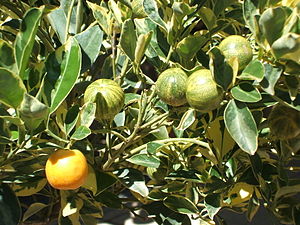Calamondin orange
| Calamondin orange | ||||||||||||
|---|---|---|---|---|---|---|---|---|---|---|---|---|

Cultivated form: Citrofortunella-Variegata |
||||||||||||
| Systematics | ||||||||||||
|
||||||||||||
| Scientific name | ||||||||||||
| × Citrofortunella microcarpa | ||||||||||||
| ( Bunge ) Wijnands |
The Calamondin ( x Citrofortunella microcarpa , Syn. : Citrus fortunella , Citrus mitis ) is a probably originally in China naturally formed hybrids from Mandarin Citrus reticulata and kumquat -Art Fortunella margarita (oval kumquat).
Today the calamondin orange is mainly grown in the Philippines , where it is called calamansi . It is also widely cultivated in other areas of East Asia and the Caribbean.
description
Citrofortunella microcarpa grows as a tree and reaches heights of 2 to 8 m. The egg-shaped leaves are significantly lighter on the underside of the leaves than on the upper, dark-green side.
The calamondin orange will already bear fruit after 4 years. The average 3 cm thick fruit, which can reach the size of a table tennis ball, tastes differently depending on the degree of ripeness. The peel and flesh are orange when ripe and taste sweet and sour, very similar to kumquats. When unripe, the skin and pulp are green; in this state the fruit is used in the Philippines as a juicy lemon fruit. In the yellowish intermediate state, it tastes more or less sweet or sour. It is rich in phosphorus , calcium , iron and vitamin C . For this reason, the juice, diluted with water and possibly sweetened with sugar, is drunk hot or cold as a preventive medicine and remedy for throat and respiratory diseases.
Cultivation
The cultivation is problem-free, only waterlogging is to be avoided. To improve the harvest, the plant should be fertilized with ammonium sulfate or urea . They are multi-fruiting, robust potted plants.
The propagation happens via head cuttings; Seedlings are not used for propagation because the propagation of cuttings works quickly and easily with this variety and the plants form sufficiently robust roots. In addition, seedlings take too long to produce fruit for the first time (around 5 to 7 years).
More Citrofortunella forms
Citrofortunella eustis , Syn .: Citrus × floridana , the Limequat , is a hybrid of kumquat and lime. The three most famous varieties are: Eustis Limequat, Lakeland Limequat and Tavares Limequat, bred by Walter T. Swingle in Florida at the beginning of the 20th century. In colder growing areas, they can replace tropical lime as a supplier of sour, highly aromatic fruits. Its fruits are yellow, extremely thin-skinned and slightly larger than the oval kumquat.
Crosses with sweet fruity citrus species
Nippon Satsumaquat, a cross between Satsuma mandarin and oval kumquat, and Kucle, a newer Italian cross. Both hybrids are popular as decorative potted plants. Their fruits are orange, tart, oblong-oval and about twice the size of the oval kumquat.
supporting documents
- Walter T. Swingle & Philip C. Reece: The Botany of Citrus and Its Wild Relatives . In: W. Reuther, HJ Webber, LD Batchelor (Eds.): The Citrus Industry , Vol. 1., University of California, 1967. Online
- Bernhard Voß: Citrus plants from tropical to hardy . Humbach & Nemazal, 1997. ISBN 3-9805521-3-6
- Bernhard Voss: Citrus plants , Franckh-Kosmos Verlags-GmbH, 2005. ISBN 3-440-10174-6
